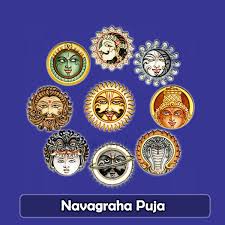
Navagraha Puja is a significant and auspicious Hindu ritual dedicated to the nine planets (Navagrahas) that influence various aspects of human life. These nine celestial bodies are: Surya (Sun), Chandra (Moon), Mangala (Mars), Budha (Mercury), Guru (Jupiter), Shukra (Venus), Shani (Saturn), Rahu (ascending lunar node), and Ketu (descending lunar node). Each of these planets is associated with specific attributes and governs different aspects of life, including wealth, health, career, relationships, and spiritual growth.
The Navagraha Puja is performed to appease the planets, mitigate any negative influences, and seek their blessings for peace, prosperity, health, and happiness. The ritual is often performed to overcome obstacles, especially when a person is experiencing malefic effects due to the positioning of planets in their horoscope or during difficult planetary periods.
Rituals and Offerings:
The puja begins with the installation of Navagraha idols or pictures, often on a sacred platform (altar), with each planet represented by a specific color, gemstone, and offering. The following steps are generally followed:
- Purification and Preparations: The worship area is cleansed, and the devotees take a purifying bath before beginning the puja.
- Invocation: The priest chants sacred mantras to invoke the grace of the planets. Specific mantras, such as the Navagraha Stotra, Navagraha Ashtakshara Mantra, and other planetary hymns, are recited.
- Offerings: Flowers, fruits, incense, lighted lamps, water, and special grains (such as rice and barley) are offered to each of the planets. Specific items like black sesame for Saturn, red flowers for Mars, and yellow offerings for Jupiter are included based on the planetary deities.
- Prayers and Pujas: Special prayers are recited, asking the planets to bestow their blessings and mitigate any malefic influences. Rituals for each planet are performed, and the priest may also conduct a homa (fire ritual) to further strengthen the puja.
Navagraha Puja is especially popular during certain occasions, such as Shani Amavasya, Graha Shanti, and during transits or dasha periods (planetary periods) in a person’s astrological chart.

